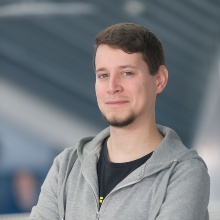Contact
Allmandring 19
70569 Stuttgart
Deutschland
Room: 01.025
2025
- Rau, Simeon ; Heyen, Frank ; Brachtel, Benedikt ; Sedlmair, Michael: MAICO: A Visualization Design Study on AI-Assisted Music Composition. In: IEEE Transactions on Visualization and Computer Graphics, Institute of Electrical and Electronics Engineers (IEEE) (2025), S. 1–16. — Holds a Replicability Stamp by the Graphics Replicability Stamp Initiative (GRSI): https://www.replicabilitystamp.org/#https-github-com-visvar-maicov2
2023
- Heyen, Frank ; Ngo, Quynh Quang ; Sedlmair, Michael: Visual Overviews for Sheet Music Structure. In: Proceedings of the 24th International Society for Music Information Retrieval Conference (ISMIR) 2023 : ISMIR, 2023, S. 692–699
2022
- Skreinig, Lucchas Ribeiro ; Stanescu, Ana ; Mori, Shohei ; Heyen, Frank ; Mohr, Peter ; Sedlmair, Michael ; Schmalstieg, Dieter ; Kalkofen, Denis: AR Hero: Generating Interactive Augmented Reality Guitar Tutorials. In: 2022 IEEE Conference on Virtual Reality and 3D User Interfaces Abstracts and Workshops (VRW) : IEEE, 2022, S. 395–401
- Rau, Simeon ; Heyen, Frank ; Wagner, Stefan ; Sedlmair, Michael: Visualization for AI-Assisted Composing. In: Proceedings of the 23rd International Society for Music Information Retrieval Conference. Bengaluru, India : ISMIR, 2022, S. 151–159
- Heyen, Frank ; Sedlmair, Michael: Augmented Reality Visualization for Musical Instrument Learning (2022)
- Heyen, Frank ; Ngo, Quynh Quang ; Kurzhals, Kuno ; Sedlmair, Michael: Data-Driven Visual Reflection on Music Instrument Practice. In: ACM CHI Workshop on Intelligent Music Interfaces (IMI) : ACM, 2022
- Heyen, Frank ; Kohler, Yannik ; Triebener, Sebastian ; Rigling, Sebastian ; Sedlmair, Michael: Immersive Visual Analysis of Cello Bow Movements (2022)
- Heyen, Frank ; Aygün, Dilara ; Sedlmair, Michael: A Web-Based MIDI Controller for Music Live Coding (2022)
- Achberger, Alexander ; Heyen, Frank ; Vidačković, Krešimir ; Sedlmair, Michael: Touching data with PropellerHand. In: Journal of Visualization (2022)
2021
- Rijken, Gerrit J ; Cutura, René ; Heyen, Frank ; Sedlmair, Michael ; Correll, Michael ; Dykes, Jason ; Smit, Noeska: Illegible Semantics: Exploring the Design Space of Metal Logos. In: IEEE VIS alt.VIS Workshop, 2021
- Rau, Simeon ; Heyen, Frank ; Sedlmair, Michael: Visual Support for Human-AI Co-Composition. In: Extended Abstracts for the Late-Breaking Demo Session of the 22nd Int. Society for Music Information Retrieval Conf. (ISMIR) : ISMIR, 2021
- Cutura, René ; Angerbauer, Katrin ; Heyen, Frank ; Hube, Natalie ; Sedlmair, Michael: DaRt: Generative Art using Dimensionality Reduction Algorithms. In: 2021 IEEE VIS Arts Program (VISAP) : IEEE, 2021, S. 59–72
- Achberger, Alexander ; Heyen, Frank ; Vidačković, Krešimir ; Sedlmair, Michael: PropellerHand: A Hand-Mounted, Propeller-Based Force Feedback Device. In: International Symposium on Visual Information Communication and Interaction (VINCI) : ACM, 2021, S. 4:1–4:8
2020
- Heyen, Frank ; Munz, Tanja ; Neumann, Michael ; Ortega, Daniel ; Vu, Ngoc Thang ; Weiskopf, Daniel ; Sedlmair, Michael: ClaVis: An Interactive Visual Comparison System for Classifiers. In: Proceedings of the International Conference on Advanced Visual Interfaces (AVI), AVI ’20. New York, NY, USA : Association for Computing Machinery, 2020, S. 9:1–9:9


